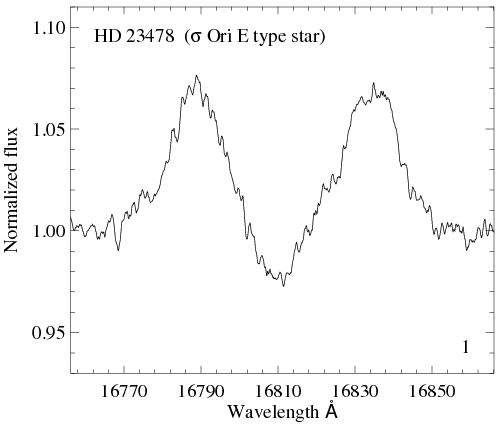This animated figure shows variation in the Br11 line (hydrogen, Brackett series, 11-4) for HD 23478, one of two new σ Ori E type stars discovered in the SDSS-III/APOGEE survey. The prototype for this type of peculiar star is σ Ori E (HD 37479), a rapidly-rotating, Helium-strong B-star with a spectral type of B2Vpe. In addtion to having a strong magnetic field of several kilo-Gauss, which B-type stars are not supposed to have, σ Ori E also has a very high rotational velocity (165 km/s, or 369,094 miles/hour). For comparison, the Sun rotates at about 2 km/s, or 4,467 miles/hour.

It is strongly suspected, but not yet officially confirmed, that HD 23478 possesses a magnetic field of strength similar to σ Ori E. We do know that the star is a radid rotator like σ Ori E, with vsini=125 km/s, or 279,617 miles/hour. Massive B stars produce strong winds, and in the case of σ Ori E stars, the contents of these winds (mostly hydrogen gas) can become trapped in locations where the rotational and magnetic equators overlap. This gas may be several stellar radii from the star, but due to the magnetic confinement, it rotates at the same speed as the surface of the star. Observationally, we see this in the form of double-peaked hydrogen emission lines, with very widely spaced emission peaks (peak separation ~900 km/s in the below figure). Due to the rapid rotation, these stars have small rotational periods of typically a day or less, hence the rapid variability in the emission line profiles as the rigidly rotating magnetospheres trace the stars' orbits.